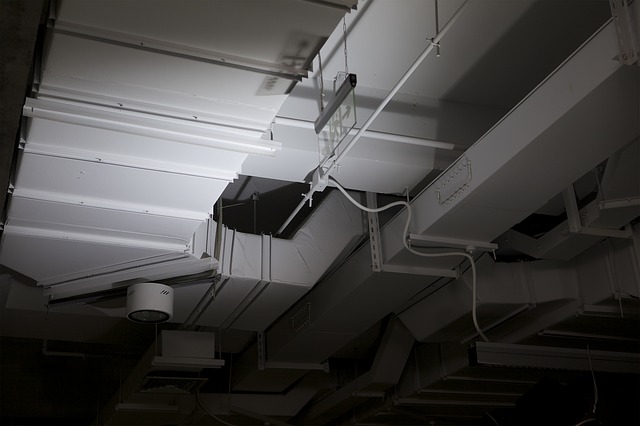Air change rates
Contents |
[edit] Introduction
Air is continuously exchanged between buildings and their surroundings as a result of mechanical and passive ventilation and infiltration through the building envelope. The rate at which air is exchanged is an important property for the purposes of ventilation design and heat loss calculations and is expressed in ‘air changes per hour’ (ach).
If a building has an air change rate of 1 ach, this equates to all of the air within the internal volume of the building being replaced over a 1 hour period.
[edit] Calculating air change rates
A number of techniques are available for calculating the air change rate of a building. The choice of method depends on the accuracy required. The most straightforward method relies on the use of a simple mathematical equation, while the most complex methods use computational analysis and consider many different variables (such as computational fluid dynamics).
The basic method calculates air change rates using the following equation:
n = 3,600 x q / V
Where:
n = Air changes per hour (ach)
q = Fresh air flow rate (m3/s)
Online air change rate calculators and tables are available for different room types, such as: https://www.electricalworld.com/en/Air-Change-Calculator-and-Table/cc-48.aspx
[edit] Measuring air change rates
Air change rates resulting from ventilation can be quantified by measuring the air velocity at selected positions within supply ducts. The velocities are normally measured using a pitot tube connected to a pressure gauge or manometer, or using a hot wire probe and meter.
Tracer gas measurement can be used to determine the average air change rate for naturally'-'ventilated spaces' and to measure infiltration (air tightness)'. To do this, a detectable, non-toxic gas is released into the space and the reduction in its concentration within the internal atmosphere is monitored over a given time period.'
For more information, see Air permeability testing.
[edit] Legislation and guidance
Specific air change rates are required in buildings to control internal temperatures and to introduce clean, oxygen-rich air and remove stale, humid air. The requirements will vary depending on a number of factors including; the type of space, the level of occupation and usage and the geographical location of the building.
In the UK, several legislative documents have been published that set appropriate standards for air change rates in different types of construction.
Approved document F sets out the minimum requirements for ventilation to provide comfortable conditions and to prevent surface and interstitial condensation. Approved document F expresses air change rates in a number of different ways:
- air changes per hour.
- litres per second (l/s).
- l/s per m^2 of internal floor area.
- l/s per piece of equipment.
- l/s per person.
For many types of building, the approved document simply refers to standards set in CIBSE Guide B: Heating, ventilating, air conditioning and refrigeration.
A wide range other guidance is also available, including CIBSE KS17: Indoor air quality and ventilation, which provides information about the required air change rates to achieve acceptable indoor air quality, and BS 5925: Code of practice for ventilation principles and designing for natural ventilation, which sets out recommended air flow rates for natural ventilation.
[edit] Related articles on Designing Buildings
- Air infiltration.
- Air permeability testing.
- Air quality.
- Air Quality Taskforce.
- Air tightness in buildings.
- Computational fluid dynamics.
- Draughts in buildings.
- Effective ventilation in buildings.
- Indoor air quality.
- Stale air.
- The history of non-domestic air tightness testing.
- UV disinfection of building air to remove harmful bacteria and viruses.
- Ventilation.
[edit] External references
- Building Regulations: Approved Document F – Ventilation.
- CIBSE KS17: Indoor Air Quality and Ventilation.
- CIBSE Guide B: Heating, ventilating, air conditioning and refrigeration.
- BS 5925: Code of practice for ventilation principles and designing for natural ventilation.
- https://www.electricalworld.com/en/Air-Change-Calculator-and-Table/cc-48.aspx
Featured articles and news
RTPI leader to become new CIOB Chief Executive Officer
Dr Victoria Hills MRTPI, FICE to take over after Caroline Gumble’s departure.
Social and affordable housing, a long term plan for delivery
The “Delivering a Decade of Renewal for Social and Affordable Housing” strategy sets out future path.
A change to adoptive architecture
Effects of global weather warming on architectural detailing, material choice and human interaction.
The proposed publicly owned and backed subsidiary of Homes England, to facilitate new homes.
How big is the problem and what can we do to mitigate the effects?
Overheating guidance and tools for building designers
A number of cool guides to help with the heat.
The UK's Modern Industrial Strategy: A 10 year plan
Previous consultation criticism, current key elements and general support with some persisting reservations.
Building Safety Regulator reforms
New roles, new staff and a new fast track service pave the way for a single construction regulator.
Architectural Technologist CPDs and Communications
CIAT CPD… and how you can do it!
Cooling centres and cool spaces
Managing extreme heat in cities by directing the public to places for heat stress relief and water sources.
Winter gardens: A brief history and warm variations
Extending the season with glass in different forms and terms.
Restoring Great Yarmouth's Winter Gardens
Transforming one of the least sustainable constructions imaginable.
Construction Skills Mission Board launch sector drive
Newly formed government and industry collaboration set strategy for recruiting an additional 100,000 construction workers a year.
New Architects Code comes into effect in September 2025
ARB Architects Code of Conduct and Practice available with ongoing consultation regarding guidance.
Welsh Skills Body (Medr) launches ambitious plan
The new skills body brings together funding and regulation of tertiary education and research for the devolved nation.
Paul Gandy FCIOB announced as next CIOB President
Former Tilbury Douglas CEO takes helm.
UK Infrastructure: A 10 Year Strategy. In brief with reactions
With the National Infrastructure and Service Transformation Authority (NISTA).
























